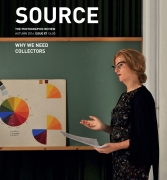Advertising
Porsche Panamera
by Judith Williamson
Issue 87 Autumn 2016
View Contents ▸
In a weekend colour supplement, a double-page spread opens onto yet another familiar-looking car ad. The gleaming Porsche, light reflecting off its curves, is seen against an urban backdrop that says both ‘smart’ and ‘bohemian’. The car is sleek, photographed from an angle that makes it look long and low, and has the exotic touch of a foreign number plate. It is shown parked on a single space in a narrow street which looks like somewhere in Bloomsbury – the row includes an old commercial building with modern plate glass doors, small-scale industrial premises and a period shop/café frontage. The effect is at once specific, and generic: this is a cool, fast car in a city setting that suggests fashionable intellectual life.
To grasp the full meaning of this setting, one has to imagine it swapped for a different one: a street of glossy high-end shops, for example, or a solely residential street of townhouses. These are indeed the kinds of settings frequently used in car ads to posit the car’s driver with a high degree of social precision. The car simply has to be shown parked in such contexts and we understand where the hypothetical owner shops, or lives. The urban setting shown here is equally resonant but suggests neither retail, nor domicile: it suggests work, and work in a particular kind of zone. Again, the precise connotations of the ad can be brought into focus by considering alternatives – if the Porsche had been parked among the imposing institutional buildings of a financial district, or outside a modern office block, or in an entirely industrial landscape. In this ad, the particular elements of the backdrop suggest a working arena that combines intimacy (the narrowness of the street), classiness (the period brick building which, with its plate-glass doors, is clearly not a home), ramshackleness (the shabby whitepainted street door with multiple bells and a noticeably fat cable running through the side), small-scale industrialness (the metal shutter which suggests some kind of yard beyond the
cobbled entrance) and aesthetic charm (the arched frontage to the right). This mixture suggests a neighbourhood where cultural work takes place – publishing, digital media, design? – work with an ambience of cutting-edge creativity, serious yet ‘alternative’.
The car-and-backdrop is such a familiar image type that the rather unusual nature of the backdrop here doesn’t immediately jump out. Equally, the ad’s caption has the familiar terseness of those pointless phrases found so often on film posters, phrases that use abstract words, usually in threes, with lots of full stops. "The new Panamera." (Three words, full stop.) "Courage changes everything." (Three words, full stop.) Courage changes everything: this seems to be exactly one of those poster-type phrases that sound deeply portentous but have no actual meaning. The ad here, like many in print nowadays, is part of a wider campaign where online videos provide the fuller rationale for the still image and text. The video short for the new Panamera works up an explanation for the ad’s caption: "They called it madness. Building the car of your dreams... Madness! Launching a turbo-charged super-sportscar in the midst of a worldwide oil crisis... Madness! Let them call it madness – we call it courage. The courage to build a sports car with four business class seats. The courage to upgrade not only the driving but also the driver. The courage to transfer an unmistakeable design DNA and breed a luxury saloon that was born on the racetrack and is at home on the roads. We call it courage. And courage will change everything."
This kind of ad prattle is familiar enough. The content here confirms that the product is meant to convey a sense of daring, defying convention and expectation. Criticism can thus be turned on its head – "launching a turbo-charged super-sportscar in the midst of a world-wide oil crisis... Madness!" (but aren’t we daring to do it!). The verbal narrative of defiance in this script resonates with the off-beat city setting in the picture to suggest an aura of radical chic – as if a Porsche in this context is subversive. "The courage to upgrade not only the driving but the driver": while it isn’t clear what that enigmatically abstract phrase actually means, it hints at a different kind of Porsche driver, one invested less in ‘the racetrack’ and more in cultural capital. The ‘upgrade’ works both ways: if you are an urban creative, you can be bravely subversive by driving a Porsche; if you are a Porsche driver, you can be bravely subversive by becoming an urban creative.
If a connotation of subversion is produced by these elements of image and script, there is a much more blatant raiding of actual radicalism, and a more extreme up-ending of its meaning, in the ad’s caption. "Courage changes everything" has a familiar ring not just because it is written in typical posterspeak, but because it is two-thirds of the title of Naomi Klein’s best-seller about capitalism and climate change, This Changes Everything. On the one hand, the nerve of this expensive car ad is mind-blowing, ripping off the title of a book which explains exactly what the problem is not only with cars themselves – their physical effects on the atmosphere – but with the economic system that continues to produce them despite these effects. (Madness! one might say.) But on the other hand, the endless capacity of advertising, and the capitalism it serves, to chew up and regurgitate the language of opposition is utterly familiar.
Other articles by Judith Williamson:
Other articles on photography from the 'Advertising' category »





